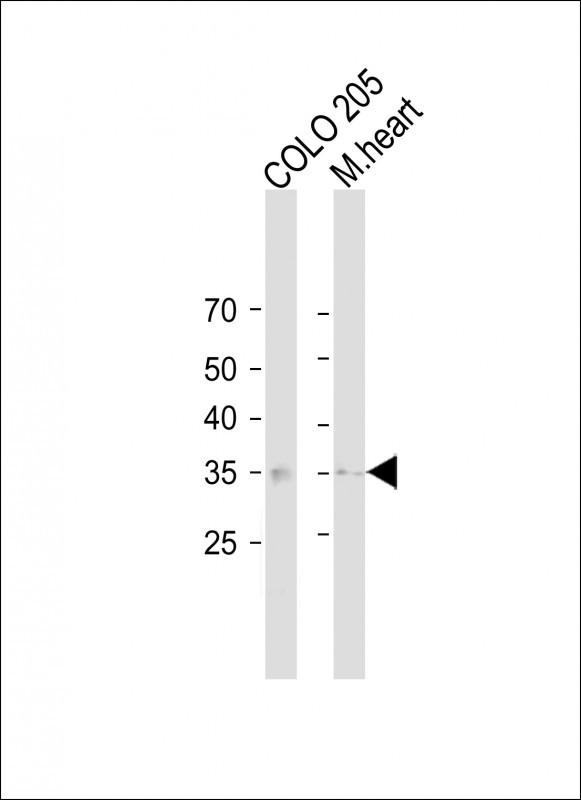MC1R Antibody (Center)
Mouse Monoclonal Antibody (Mab)
- 产品详情
- 实验流程
- 背景知识
Application
| WB, E |
|---|---|
| Primary Accession | Q01726 |
| Other Accession | NP_002377.4 |
| Reactivity | Human |
| Host | Mouse |
| Clonality | Monoclonal |
| Isotype | IgM |
| Clone Names | 578CT6.2.3 |
| Calculated MW | 34706 Da |
| Antigen Region | 205-232 aa |
| Gene ID | 4157 |
|---|---|
| Other Names | Melanocyte-stimulating hormone receptor, MSH-R, Melanocortin receptor 1, MC1-R, MC1R, MSHR |
| Target/Specificity | This MC1R antibody is generated from mice immunized with a KLH conjugated synthetic peptide between 205-232 amino acids from the Central region of human MC1R. |
| Dilution | WB~~1:250 E~~Use at an assay dependent concentration. |
| Format | Purified polyclonal antibody supplied in PBS with 0.05% (V/V) Proclin 300. This antibody is prepared by Saturated Ammonium Sulfate (SAS) precipitation followed by dialysis against PBS. |
| Storage | Maintain refrigerated at 2-8°C for up to 2 weeks. For long term storage store at -20°C in small aliquots to prevent freeze-thaw cycles. |
| Precautions | MC1R Antibody (Center) is for research use only and not for use in diagnostic or therapeutic procedures. |
| Name | MC1R |
|---|---|
| Synonyms | MSHR |
| Function | Receptor for MSH (alpha, beta and gamma) and ACTH (PubMed:11442765, PubMed:11707265, PubMed:1325670, PubMed:1516719, PubMed:8463333). The activity of this receptor is mediated by G proteins which activate adenylate cyclase (PubMed:11707265, PubMed:1325670, PubMed:16463023, PubMed:19737927). Mediates melanogenesis, the production of eumelanin (black/brown) and phaeomelanin (red/yellow), via regulation of cAMP signaling in melanocytes (PubMed:31097585). |
| Cellular Location | Cell membrane; Multi-pass membrane protein |
| Tissue Location | Expressed in melanocytes (PubMed:1325670, PubMed:31097585). Expressed in corticoadrenal tissue (PubMed:1325670) |
For Research Use Only. Not For Use In Diagnostic Procedures.
Provided below are standard protocols that you may find useful for product applications.
BACKGROUND
This intronless gene encodes the receptor protein for melanocyte-stimulating hormone (MSH). The encoded protein, a seven pass transmembrane G protein coupled receptor, controls melanogenesis. Two types of melanin exist: red pheomelanin and black eumelanin. Gene mutations that lead to a loss in function are associated with increased pheomelanin production, which leads to lighter skin and hair color. Eumelanin is photoprotective but pheomelanin may contribute to UV-induced skin damage by generating free radicals upon UV radiation. Binding of MSH to its receptor activates the receptor and stimulates eumelanin synthesis. This receptor is a major determining factor in sun sensitivity and is a genetic risk factor for melanoma and non-melanoma skin cancer. Over 30 variant alleles have been identified which correlate with skin and hair color, providing evidence that this gene is an important component in determining normal human pigment variation. [provided by RefSeq].
REFERENCES
Demenais, F., et al. J. Natl. Cancer Inst. 102(20):1568-1583(2010)
Strange, R.C., et al. Mult. Scler. 16(9):1109-1116(2010)
Ibarrola-Villava, M., et al. Exp. Dermatol. 19(9):836-844(2010)
Smith, G., et al. Pharmacogenet. Genomics (2010) In press :
Kricker, A., et al. Cancer Causes Control (2010) In press :
终于等到您。ABCEPTA(百远生物)抗体产品。
点击下方“我要评价 ”按钮提交您的反馈信息,您的反馈和评价是我们最宝贵的财富之一,
我们将在1-3个工作日内处理您的反馈信息。
如有疑问,联系:0512-88856768 tech-china@abcepta.com.























 癌症的基本特征包括细胞增殖、血管生成、迁移、凋亡逃避机制和细胞永生等。找到癌症发生过程中这些通路的关键标记物和对应的抗体用于检测至关重要。
癌症的基本特征包括细胞增殖、血管生成、迁移、凋亡逃避机制和细胞永生等。找到癌症发生过程中这些通路的关键标记物和对应的抗体用于检测至关重要。 为您推荐一个泛素化位点预测神器——泛素化分析工具,可以为您的蛋白的泛素化位点作出预测和评分。
为您推荐一个泛素化位点预测神器——泛素化分析工具,可以为您的蛋白的泛素化位点作出预测和评分。 细胞自噬受体图形绘图工具为你的蛋白的细胞受体结合位点作出预测和评分,识别结合到自噬通路中的蛋白是非常重要的,便于让我们理解自噬在正常生理、病理过程中的作用,如发育、细胞分化、神经退化性疾病、压力条件下、感染和癌症。
细胞自噬受体图形绘图工具为你的蛋白的细胞受体结合位点作出预测和评分,识别结合到自噬通路中的蛋白是非常重要的,便于让我们理解自噬在正常生理、病理过程中的作用,如发育、细胞分化、神经退化性疾病、压力条件下、感染和癌症。






